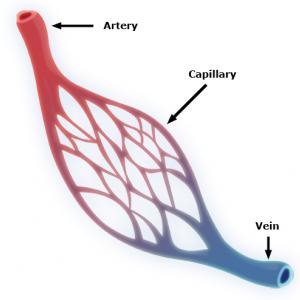College of Liberal Arts & Sciences
11A10.32 - Veins and Arteries
- Bradley Moser, "Teach Poiseuille First - A Call for a Paradigm Shift in Fluid Dynamics Education", TPT, Vol. 59, #7, Oct. 2021, p. 552.
- Benjamin Spitznagel, Justin Weigal, and Juan Rodriguez, "Visualizing Viscous Flow and Diffusion in the Circulatory System", TPT, Vol. 57, #8, Nov. 2019, p. 529.
- Carl E. Mungan, "Pressure Change in an Arterial Constriction", TPT, Vol. 53, #9, Dec. 2015, p. 561.
- H. Richard Crane, "Folded-Path Doppler and the Measurement of Blood Flow", TPT, Vol. 37, #6, Sept. 1999, p. 362.
- Gerry McClelland, "Some Nice Distinctions", TPT, Vo. 28, #3, Mar. 1990, p. 134.
- Alan Van Heuvelen, "Physics of the Circulatory System", TPT, Vo. 27, #8, Nov. 1989, p. 590.
- Michael A. Waxman, "Using Physics to Investigate Blood Flow in Arteries: A Case Study for Premed Students", AJP, Vol. 78, #9, Sept. 2010, p. 970.
- L. J. Bruner, "Cardiovascular Simulator for the Undergraduate Physics Laboratory", AJP, Vol. 47, #7, July 1979, p. 608.
- J. Richard Shanebrook, "Fluid Mechanics of Coronary Artery Bypass Surgery", AJP, Vol. 45, #7, July 1977, p. 677.
- Charles Day, "Single, Physics-Based Model Accounts for the Mechanical Properties of Diverse Biopolymer Gels", Physics Today, Vol. 58, #7, July 2005, p. 27.
- "Bloodstream", Uncle John's Bathroom Reader, p. 137.
- Jearl Walker, "3.49. Korotkoff Sounds", The Flying Circus of Physics Ed. 2, p. 165 - 166.
- Jearl Walker, "2.47. Blood Circulation in Snakes, Giraffes, and Tall Dinosaurs", The Flying Circus of Physics Ed. 2, p. 100 - 101.
- Sara Stein, "See Your Blood Vessels", The Science Book, p. 126.
- Harvard Natural Sciences Lecture Demonstrations, "Laplace's Law and Aneurysms".
- John R. Cameron and Richard E. Berg, "A Question About Ballistocardiography", Tap-L Discussion, 08/29/2004.
- Julius Sumner Miller, Q142 & A142, Millergrams II – Some More Enchanting Questions for Enquiring Minds, p. 26 & 86.
Disclaimer: These demonstrations are provided only for illustrative use by persons affiliated with The University of Iowa and only under the direction of a trained instructor or physicist. The University of Iowa is not responsible for demonstrations performed by those using their own equipment or who choose to use this reference material for their own purpose. The demonstrations included here are within the public domain and can be found in materials contained in libraries, bookstores, and through electronic sources. Performing all or any portion of any of these demonstrations, with or without revisions not depicted here entails inherent risks. These risks include, without limitation, bodily injury (and possibly death), including risks to health that may be temporary or permanent and that may exacerbate a pre-existing medical condition; and property loss or damage. Anyone performing any part of these demonstrations, even with revisions, knowingly and voluntarily assumes all risks associated with them.
